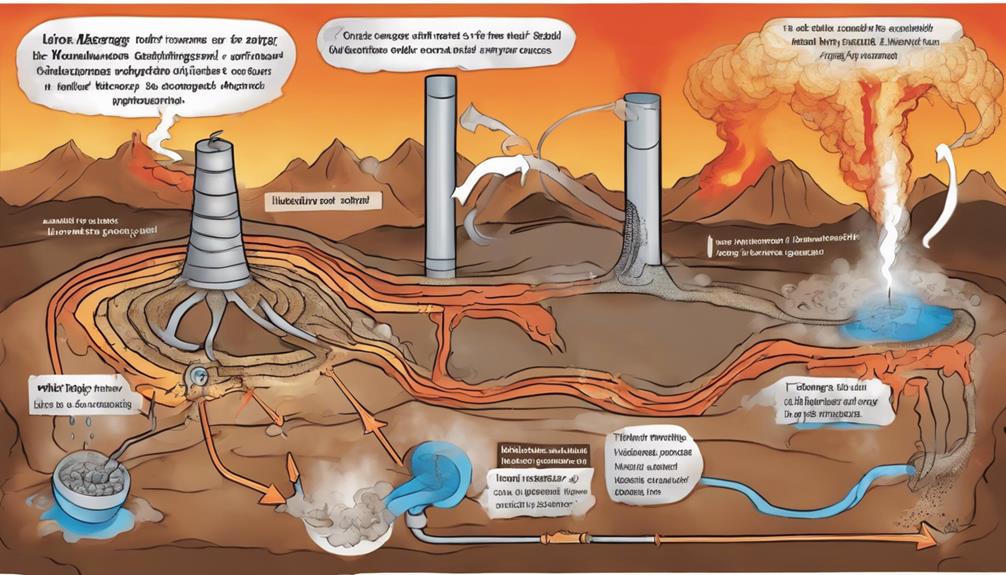You're about to discover the key roles that inlet and outlet systems play in geothermal energy, where they facilitate heat transfer and energy exchange, and understanding their differences is essential to optimizing system performance. The inlet is where the heat transfer fluid enters the system, while the outlet is where it exits after releasing or absorbing heat. Inlet temperature directly impacts system performance, and outlet temperature determines geothermal energy transfer effectiveness. As you explore the intricacies of inlet and outlet systems, you'll uncover how temperature differences drive energy production and how fine-tuning these systems can greatly enhance efficiency.
Key Takeaways
- Inlet is where cold water enters the geothermal system, while outlet is where heated water or steam exits, carrying heat energy.
- Inlet temperature directly impacts system performance, while outlet temperature determines geothermal energy transfer effectiveness.
- Inlet temperature affects heat transfer efficiency, determining the amount of heat extracted from geothermal sources.
- Outlet temperature gauges system efficiency in heating or cooling, with higher temperatures indicating more efficient heat transfer.
- Monitoring and controlling both inlet and outlet temperatures optimizes energy extraction, consumption, and overall system performance.
Understanding Inlet and Outlet Systems
As you explore geothermal energy systems, understanding the fundamental concept of inlet and outlet systems is pivotal, as they play a significant role in facilitating heat transfer and energy exchange.
The inlet is where the heat transfer fluid enters the system, carrying heat from the ground, while the outlet is where the fluid exits after releasing or absorbing heat, depending on the system's function.
The inlet temperature is essential for efficient heat exchange, directly impacting the overall performance of geothermal systems. Similarly, the outlet temperature determines the effectiveness of geothermal energy transfer for heating or cooling applications.
To optimize system performance and energy efficiency, it's crucial to monitor and control both inlet and outlet temperatures. By doing so, you can guarantee that the heat exchange process occurs at the best temperature, resulting in maximum efficiency and minimal energy loss.
Effective monitoring and control of inlet and outlet temperatures are key components of a well-designed geothermal energy system, allowing you to harness the full potential of this renewable energy source.
Geothermal Energy Cycle Process

You're now ready to explore the geothermal energy cycle process, which relies on the continuous circulation of water or steam to facilitate heat exchange and energy production.
In this cycle, cold water enters the system through the inlet, absorbing heat from the underground reservoir as it flows through.
As the heated water or steam exits the system through the outlet, it carries the heat energy that will be used to generate power.
The temperature difference between the inlet and outlet is essential, as it drives the energy production process.
The geothermal energy cycle is all about optimizing performance by maintaining an efficient heat exchange between the inlet and outlet.
By monitoring the inlet and outlet temperatures, you can guarantee effective heat transfer and maximize energy output.
This continuous circulation of water or steam enables the geothermal energy cycle to produce electricity while minimizing waste and environmental impact.
As you dig deeper into the geothermal energy cycle process, you'll understand how this temperature difference is harnessed to generate clean and sustainable energy.
Inlet Temperature and Heat Transfer

Controlling the inlet temperature is key to tapping into the full potential of geothermal energy, since it directly impacts the efficiency of heat transfer within the system.
As you explore the world of geothermal energy, you'll realize that the inlet temperature plays an essential role in determining the amount of heat that can be extracted from the ground or geothermal source.
This initial temperature of the fluid entering the system sets the stage for the heat transfer process, affecting the thermal performance and overall efficiency of the system.
By monitoring and controlling the inlet temperature, you can optimize the heat transfer process, maximizing energy extraction and improving the system's overall performance.
Understanding the relationship between the inlet and outlet temperatures is also crucial for evaluating the effectiveness of geothermal energy systems. In geothermal energy systems, the inlet temperature is the initial temperature of the geothermal fluid as it enters the system, while the outlet temperature is the temperature of the fluid as it exits the system. By comparing these two temperatures, engineers can determine how much heat is being extracted from the geothermal source and converted into usable energy. This is similar to how solar panels transfer energy from sunlight into electricity, but in the case of geothermal energy, the heat from within the Earth is the source of energy. Understanding the relationship between inlet and outlet temperatures is essential for maximizing the efficiency and sustainability of geothermal energy systems.
Outlet Temperature and Efficiency

By examining the outlet temperature, you can gauge the efficiency of your geothermal system in providing top heating or cooling to buildings. The outlet temperature, which is the temperature of the fluid leaving the heat exchanger after extracting or depositing heat, plays a vital role in determining the system's efficiency. Higher outlet temperatures indicate more efficient heat transfer and better performance of geothermal energy systems. This is because a higher outlet temperature means more heat is being transferred, resulting in a more effective heating or cooling process.
Monitoring and controlling the outlet temperature is crucial for maintaining the desired indoor climate and optimizing energy consumption. By keeping the outlet temperature at an ideal level, you can reduce energy consumption and minimize the system's environmental impact.
Moreover, regular monitoring of the outlet temperature helps identify potential issues with the system, allowing for prompt maintenance and repairs. By keeping a close eye on the outlet temperature, you can guarantee your geothermal system operates at its peak, providing you with a comfortable and sustainable indoor climate.
Maximizing Geothermal Performance

To enhance geothermal performance, focusing on optimizing the temperature and flow rate at the inlet is vital, as this directly impacts the system's ability to efficiently transfer heat. When you're using geothermal energy, getting the most out of your system is crucial. By optimizing the inlet conditions, you can increase the power output and make your system more sustainable.
Here are some key strategies to help you maximize geothermal performance:
- Perform a parametric study to identify the best inlet temperature and flow rate for your specific system.
- Monitor the inlet and outlet temperatures to ensure effective thermal transfer.
- Design your heat pump systems with the temperature boundary in mind, making sure that the heat transport is maximized.
- Adjust the flow rate to optimize the heat exchange process.
- Consider using advanced materials or coatings to improve heat transfer and reduce losses.
Frequently Asked Questions
What Is the Inlet and Outlet of a Plate Heat Exchanger?
You're wondering what the inlet and outlet of a plate heat exchanger are. Well, you'll find the inlet where hot or cold fluid enters for heat exchange, and the outlet where the fluid exits after transferring heat.
What Is the Temperature Difference Between the Inlet and the Outlet of an Air Cooled Engine?
You might be surprised to know that a 10°C temperature difference can boost engine efficiency by up to 5%! When it comes to air-cooled engines, you'll typically see a 20-30°C difference between the inlet and outlet temperatures, depending on operating conditions.
What Are the Parts of Geothermal Energy?
You're exploring geothermal energy, and you want to know its parts. Geothermal energy involves a system that harnesses heat from underground sources to generate electricity or provide heat.
What Are the Two Geothermal Systems?
As you immerse yourself in the world of geothermal energy, you're likely wondering what the two main systems are – you're about to uncover the secrets of Open-Loop and Closed-Loop systems, each with its unique benefits and applications!
Conclusion
You've grasped the concept of inlet and outlet in geothermal energy – now imagine a system that's a million times more efficient!
Picture a geothermal plant where inlet temperatures are scorching hot, and outlet temperatures are icy cool.
It's like a never-ending cycle of heat and energy, where the inlet is the fiery heart of the operation, and the outlet is the calm, collected brain that makes it all work in perfect harmony.









